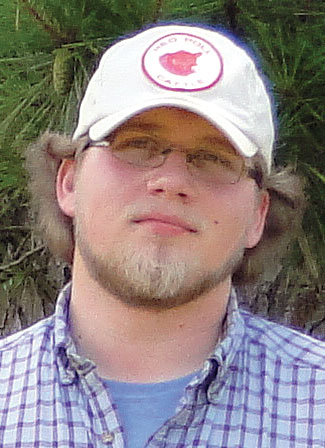
Hunter Lancaster was raised on a his family’s working cattle ranch. The operation involves production of Angus/Angus cross on 1,000 acres located in Chouteau, Okla.
Growing up, Hunter worked along side his parents, Jeff and Nancy Lancaster. Today, Hunter is the main manager of the operation.
“In the past eight years under Hunter’s management, he has tripled our productivity,” Nancy said, adding that they were able to keep all of their cattle during a drought year because Hunter harvested corn stocks in the middle of the night.
She explained she and Jeff wanted Hunter to attend college for at least one semester when he graduated from high school in 2009 before he began ranching full time. One semester at Connors State College in Warner, Okla., turned into two years, which Hunter admits taught him a great deal including how to work “smarter rather than harder” on the farm. Hunter also found while attending school that he definitely did not like living in town.
“When I could hear the McDonald’s drive-through from where I lived, I knew I needed to go home to the ranch,” Hunter said.
Jeff works an off-the-farm job that requires him being gone from home much of the time, while Nancy works in Wagoner, Okla.
One year after Hunter returned to the farm, the district conservationist saw the rapid progress Hunter made using conservation programs through NRCS, and mentioned an opening for a soil conservation technician. Hunter has now been employed as a technician for four years, inspecting both works in progress and completed projects as well as offering technical assistance or simple advice
“Because I am both a technician and a farmer, I feel I can relate with issues well and help people, but I love coming home to the farm best,” Hunter said.
The Lancaster ranch was started in 1941 by Hunter’s great-grandfather, Euel Lancaster.
Hunter’s parents live in the renovated homestead, while Hunter is building a home a short distance away. Jeff and Nancy purchased the ranch from the family and started their operation in 1991 with registered Angus and used AI to improve genetic quality cost-effectively. Hunter remembers his dad cutting wood when he was 2 and leaving him in the truck. Getting bored, Hunter took a screwdriver and broke all of the gauge windows. As an adult, however, he has no time to be bored.
The current operation consists of 200 commercial and Angus-influenced mommas. AI is used to raise replacement heifers with carefully selected proven mommas and semen from bulls selected according to what is needed. This process keeps the bloodlines varied and healthy. The rest of the herd is bred naturally by registered Angus or Charolais/Angus bulls. Jeff said the Charolais /Angus bulls help add muscle and bone strength, as well as a slightly improved pounds/gain ratio.
The Lancasters run both spring and fall calving cows.
Cows are generally culled if they are older and miss a cycle, if they don’t raise their own calves, if milk production is not adequate or for various health or soundness issues.
“My mom is better at culling because my dad is a bit soft on the cows,” Hunter said with a laugh.
Another difference of opinion occurs over phenotype with Nancy and Jeff being pickier than Hunter, who just wants a healthy calf.
Part of Hunter’s success in increasing production is due to diversifying the herd by taking advantage of 280 acres left untouched for 10 years.
To help with the process, Hunter bought a few Longhorn/Corriente cows, which he said are considered “goats of the cattle species.” He later sold them at a profit when he was then able to purchase “Super Baldies” with their Brahman influence to graze that land. He felt that cross was better able to tolerate heat and insects. These “Super Baldies” he bred to a purebred Angus bull which, according to Hunter, “knocks the ears off” the calves, which subsequently bring better prices.
Calves are usually weaned at 500 pounds and sold at 600 pounds, 45 days after feeding in a hay meadow and receiving creep feed. Lightweight calves, especially those from first-time heifers, are placed on no-till wheat pastures. All cattle receive salt and mineral with the mineral for the summer containing fly control. During the fall and winter, cattle receive 14 percent protein commercial grain mix with a vita-pack one day and haylage the next.
Haying and land care is an important part of Lancaster profitability and philosophy.
“I am a land steward and want to make the land even better for the next generation so it can be profitable forever,” Hunter said. “I would like to pass it on and keep it in the family.”
The Lancasters bale 1,500 bales a year, with additional custom baling and some hay on shares. They set aside 150 acres for hay with 50 for spring no till oats or wheat turned into haylage to defray feeding costs. The other 100 acres are Bermuda and mixed native grasses.
Hunter has plans for future improvements including using Spanish goats in rotation with cattle to reduce the need for spraying.
The Lancasters are representative of many family operations. Each member has areas of expertise respected by the others, and decisions, while made together, are not without debate.







